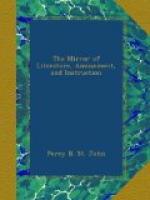This will account for the piggish habits and propensities so conspicuous in the inhabitants of certain places in England, and whose partiality for swine’s flesh, is proverbial. The sheepish manners of our students and school-boys, may also be attributed to the mutton so generally alloted to them. I might continue my observations, ad infinitum. I might say, that the wisdom of the goose was discoverable in—whose love of that, “most abused of God’s creatures,” is well known: and that the sea-side predilections of a certain Bart., of festive notoriety, were occasioned by his partiality for turtle.
QUAESITOR.
* * * * *
WHITEHALL.
MARRIAGE OF ANNE BOLEYN
(For the Mirror)
The extraordinary revolution which took place in our religious institutions in the time of Henry VIII., has rendered his reign one of the most important in the annals of ecclesiastical history. For the great changes at that glorious aera, the reformation, when the clouds of ignorance and superstition were dispelled, we are principally indebted to the beauteous, but unfortunate Anne Boleyn, whose influence with the haughty monarch, was the chief cause of the abolition of the papal supremacy in England; one of the greatest blessings ever bestowed by a monarch on his country. Intimately associated with, and the principal scene of these important events, was the ancient palace of Whitehall,[3] which Henry, into whose possession it came on the premunire of Wolsey, considerably enlarged and beautified, changing its name from that of York Place, to the one by which it is still designated.
[3] WHITEHALL was originally
erected in the year 1243, by Hubert
de
Burgh, Earl of Kent, who bequeathed it to the House
of the
Blackfriars,
near “Oldborne,” where he was buried.
It was
afterwards
purchased by Walter Gray, Archbishop of York, who made
it
his town residence, and at his death, left it to that
See,
whence
it acquired the name of York House. Cardinal
Wolsey, on
his
preferment to the Archbishoprick of York, resided here,
in
great
state; but on his premunire it was forfeited (or as
some
authors
assert had been previously given by him,) to the king.
Henry
VIII. made it his principal residence, and greatly
enlarged
it,
the ancient and royal palace of Westminster having
fallen to
decay;
at the same time he enclosed the adjoining park of
St.
James’s,
which appertained to this palace as well as to that
of
St.
James’s, which that monarch had erected on the
site of an
ancient
hospital, founded before the conquest for “leprous
sisters.”
For some curious details of Wolsey’s magnificence
and
ostentation
during his residence at York Place, we refer the
reader
to the second volume of Mr. Brayley’s Londiniana.




